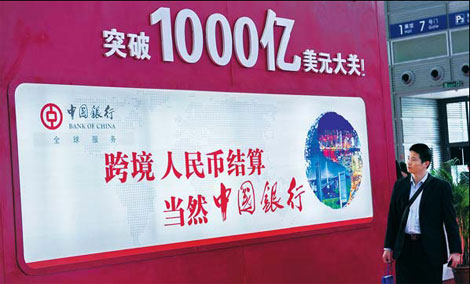Cross-border channels for the yuan to expand
Updated: 2012-01-12 07:53
By Wang Xiaotian (China Daily)
|
||||||||
|
Cross-border yuan settlements by the Bank of China Ltd have exceeded $100 billion. Officials say trade ties, a stable exchange rate and real overseas demand for the currency are buoying the cross-border yuan business. Provided to China Daily |
Global float of the Chinese currency set to be accelerated
BEIJING - China will increase cross-border circulation channels for the yuan and encourage commercial lenders to provide "packaged" financial services for companies going abroad, to accelerate the yuan's float globally, said a senior central bank official on Wednesday.
"These are the major tasks we aim for in the next phase to promote the yuan's internationalization," said Li Dongrong, assistant governor of the People's Bank of China (PBOC), in a statement on the bank's website.
He said that close international trade ties, the stable yuan exchange rate and real demand of overseas residents for the Chinese currency had established a solid foundation for the development of cross-border yuan business.
"Meanwhile, because of the global financial crisis and the constantly expanding sovereign debt problem, weaknesses and systemic risks in the current international monetary system loomed large, which provided opportunities for the yuan to float worldwide," Li said.
The government said in August that it would expand cross-border trade settlements from 20 provincial regions to the entire country. It also promised a 20 billion yuan QFII quota for Hong Kong companies to invest in mainland securities.
In October, China allowed foreign investors to make direct investments with the yuan legally obtained overseas.
Yuan-denominated trade settlements surged from $2.7 billion in the first quarter of 2010 to $90.9 billion in the third quarter of 2011.
The share of China's trade invoiced in the yuan rose from 0.39 percent to 9.33 percent during the same period.
As of the end of 2011, trade settlements in the yuan had reached a cumulative 2.58 trillion yuan ($408.57 billion), and foreign direct investment conducted in the currency had exceeded 90 billion yuan, the PBOC said.
It also said that overseas direct investment from China settled in the yuan had reached 20 billion yuan.
The central bank had signed currency-swap agreements worth 1.3 trillion yuan with 14 countries and regions by the end of 2011, including South Korea, Malaysia, Hong Kong, Belarus and Argentina, to expand the use of the yuan.
In December, Japan said that it would become the first developed economy to hold yuan-denominated bonds as reserve assets. It also said it would cooperate with China to promote the yuan's role in trade and financial transactions.
"Further progress in the yuan's internationalization implies that there is a potential crowding-out effect on the US dollar, but such an effect is more likely to emerge for trade-related transactions rather than financial activity, at least in the short term," said Zhang Zhiwei, Nomura Holdings Inc's chief economist for China.
Although China, the world's second-largest economy, aims to make the yuan a global currency, insufficient convertibility under the capital account means the yuan could only fulfill 10 percent of its potential international role, said Ma Jun, chief economist at Deutsche Bank Greater China.
"That's the real bottleneck for the next phase ... If China opens its capital account, overseas deposits in the yuan could go up to 30 trillion yuan within five years, in contrast to 2.4 trillion yuan if it doesn't allow full convertibility of the currency," he said.
Ma said that he expected China to further loosen the quota limit for foreign capital to invest in the domestic capital market.

 Relief reaches isolated village
Relief reaches isolated village
 Rainfall poses new threats to quake-hit region
Rainfall poses new threats to quake-hit region
 Funerals begin for Boston bombing victims
Funerals begin for Boston bombing victims
 Quake takeaway from China's Air Force
Quake takeaway from China's Air Force
 Obama celebrates young inventors at science fair
Obama celebrates young inventors at science fair
 Earth Day marked around the world
Earth Day marked around the world
 Volunteer team helping students find sense of normalcy
Volunteer team helping students find sense of normalcy
 Ethnic groups quick to join rescue efforts
Ethnic groups quick to join rescue efforts
Most Viewed
Editor's Picks

|

|

|

|

|

|
Today's Top News
Health new priority for quake zone
Xi meets US top military officer
Japan's boats driven out of Diaoyu
China mulls online shopping legislation
Bird flu death toll rises to 22
Putin appoints new ambassador to China
Japanese ships blocked from Diaoyu Islands
Inspired by Guan, more Chinese pick up golf
US Weekly

|

|








